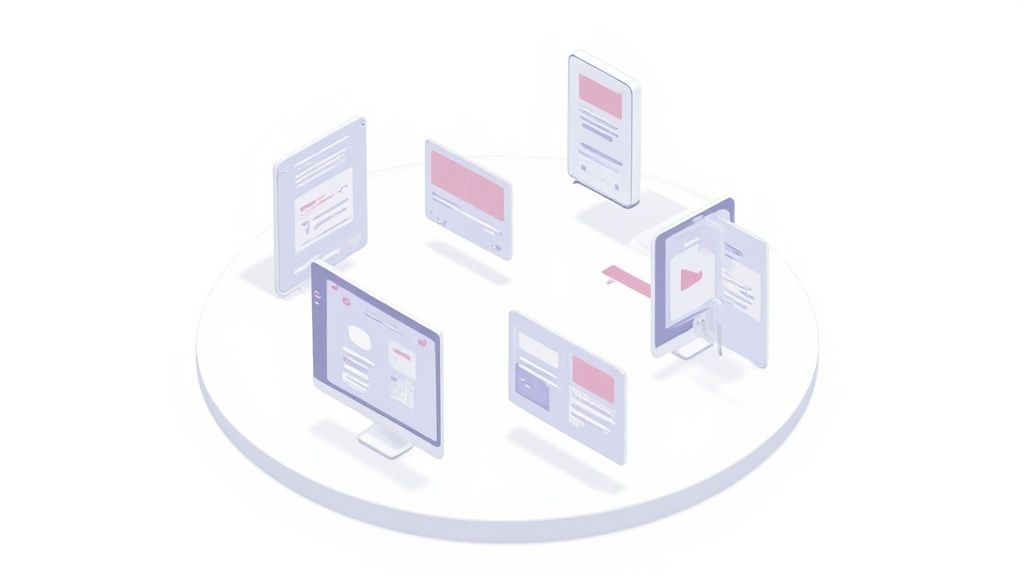In a world where users browse on everything from smartphones to widescreen monitors, a one-size-fits-all website is no longer an option. A responsive design is the cornerstone of a positive user experience, ensuring your content looks and functions perfectly on any device. But building a fully adaptive interface from scratch is a significant investment of time and resources. This is where high-quality responsive web design templates provide a critical advantage, offering a robust, pre-tested foundation for your projects. They handle the complex media queries and flexible grids, allowing you to focus on features and content.
To truly grasp the importance of creating a website that looks and functions flawlessly on any device, it's essential to understand what is mobile responsive design and its core principles. This guide cuts through the noise to showcase the best templates and marketplaces available today, from specialized SaaS kits like Magic UI Pro to extensive libraries on ThemeForest. We'll explore a mix of cutting-edge technology, design flexibility, and unique features to help you launch faster. Each option includes a breakdown of its strengths, potential drawbacks, and a direct link, so you can find the perfect starting point for your next web application or site.
1. Magic UI Pro — SaaS Template
For developers and SaaS founders seeking to launch a visually striking and high-performance web presence, the Magic UI Pro — SaaS Template stands as a premier choice. This isn't just a collection of components; it's a comprehensive, production-ready framework designed specifically for the modern SaaS landscape. By leveraging a cutting-edge tech stack that includes Next.js 14, React 18, and Tailwind CSS, it ensures your landing page is not only fast and fluid but also built on a future-proof foundation. This focus on modern technologies makes it an exceptional source for top-tier responsive web design templates.
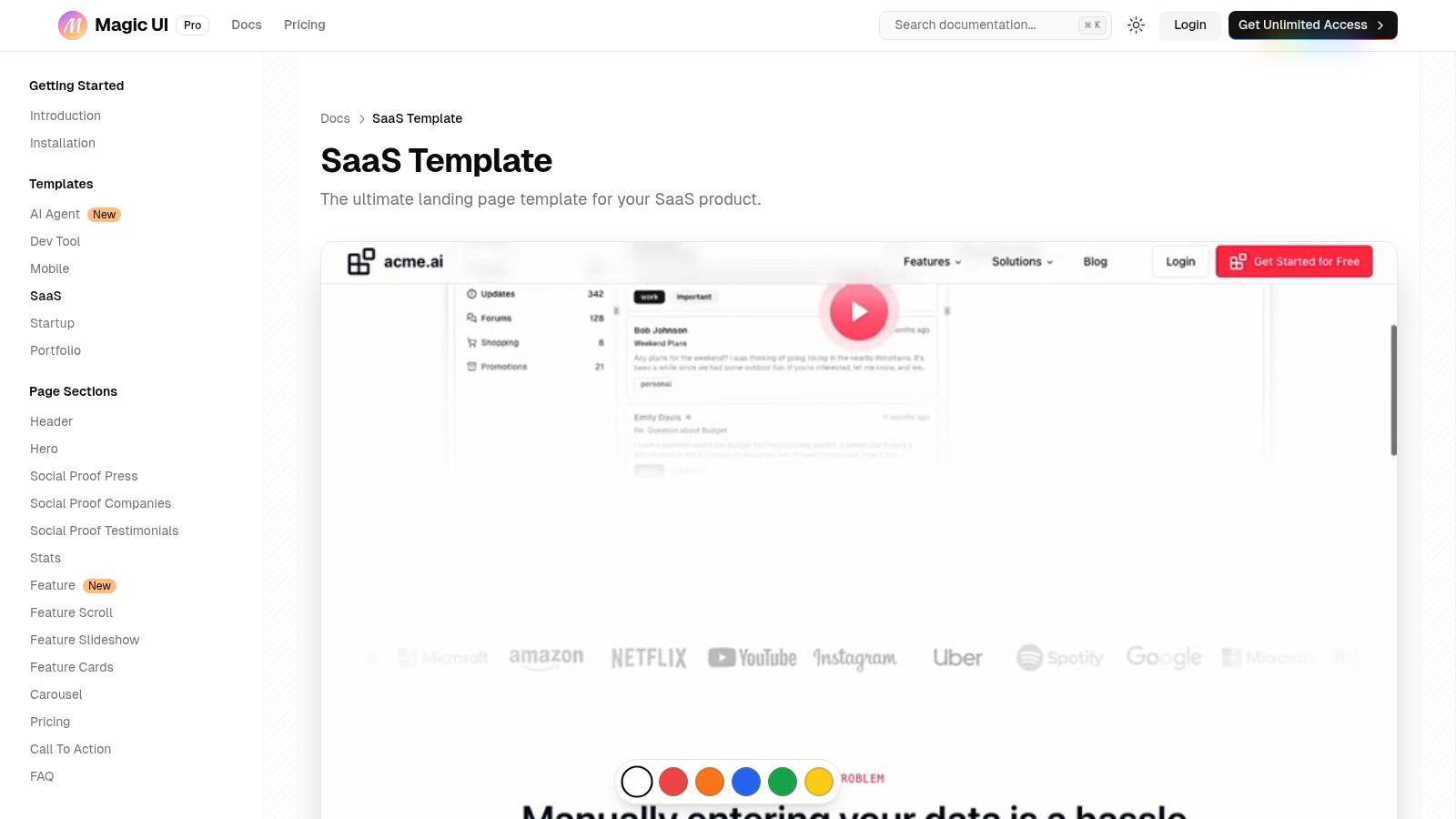
What sets Magic UI Pro apart is its meticulous attention to the specific needs of a SaaS business. The template moves beyond generic layouts, offering 14 versatile, pre-built sections meticulously crafted for SaaS use cases. These include elements for feature showcases, pricing tables, testimonials, and FAQs, allowing for rapid assembly of a complete and compelling landing page. The integrated blog functionality is a significant advantage, enabling content marketing and SEO efforts directly from your main site without needing a separate platform.
Core Strengths and Implementation
The true power of Magic UI Pro lies in its developer-centric design and immediate utility. The components are not just aesthetically pleasing; they are highly customizable and follow best practices for accessibility and performance.
- Rapid Development: Developers can significantly reduce time-to-market. Instead of building from scratch, they can customize the 14 pre-built sections, rearrange layouts, and inject their brand identity with minimal effort.
- Built-in Dark Mode: The out-of-the-box dark mode toggle is a critical user experience feature. It provides visual comfort in low-light environments and caters to user preferences, a small detail that elevates the overall perception of quality.
- SEO Optimization: The template is engineered with SEO in mind. Its clean code, fast load times from Next.js, and semantic HTML structure provide a solid base for achieving high search engine rankings without extensive post-launch tweaking.
Expert Insight: For teams leveraging React, the component-based architecture of this template is a massive accelerator. Customizing a section, for instance, involves modifying JSX props and Tailwind CSS classes, a familiar and efficient workflow for modern web developers.
The template’s structure is intuitive, making it accessible even for those with moderate React experience. You can get started and explore the full capabilities by checking out the official documentation and resources. For an in-depth look, you can learn more about the Magic UI Pro SaaS Template on magicui.design.
Website: https://pro.magicui.design/docs/templates/saas
2. ThemeForest (Envato Market)
ThemeForest stands as the largest and most established marketplace for website templates, offering an unparalleled catalog that caters to virtually every industry and niche. Operated by Envato Market, it functions as a multi-vendor platform where thousands of independent authors list their creations. This vast ecosystem makes it a go-to resource for developers and businesses searching for high-quality, feature-rich responsive web design templates at competitive prices.
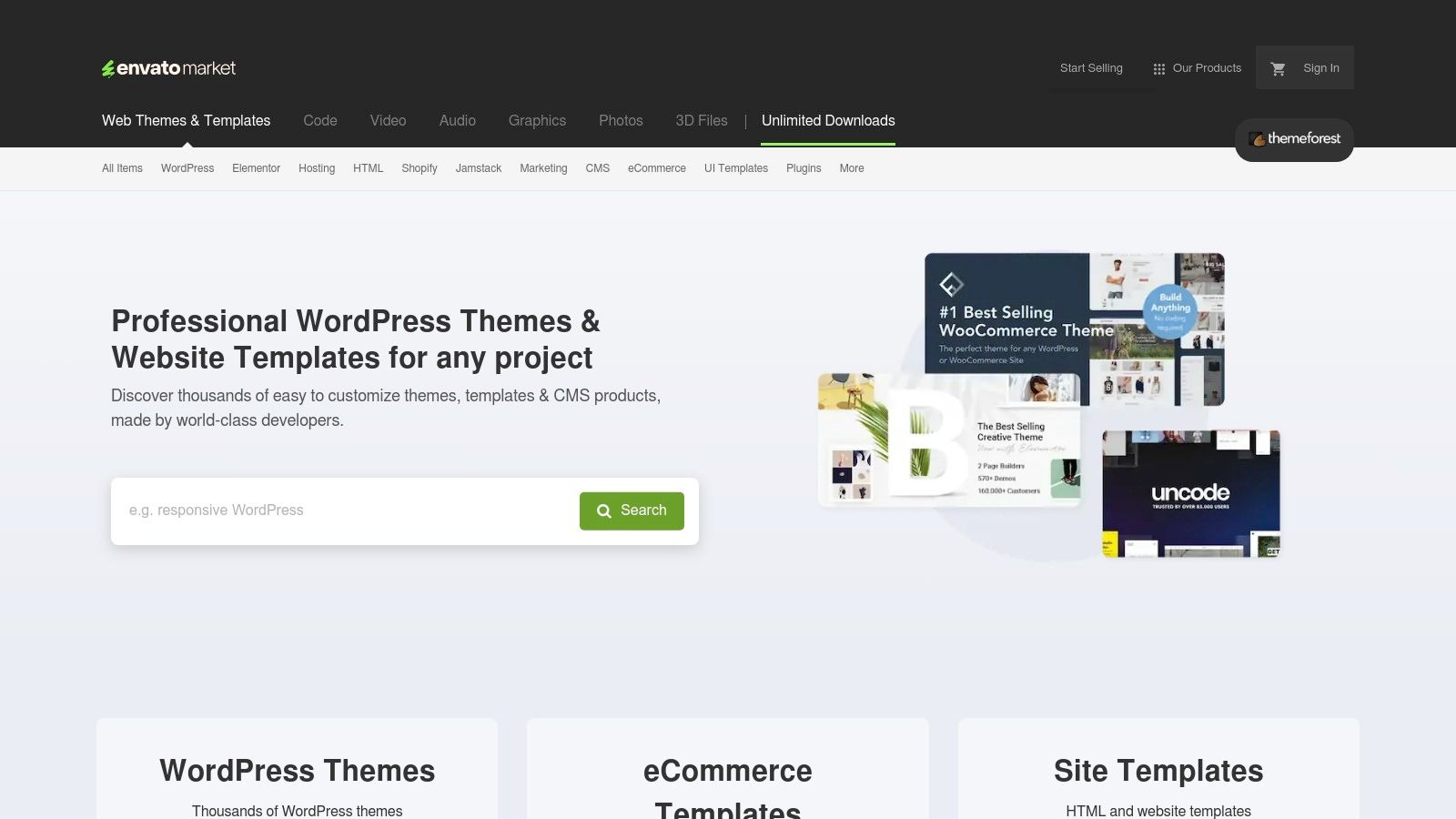
The platform’s key differentiator is its sheer volume and diversity. Whether you need a sleek one-page portfolio, a complex admin dashboard, or a niche e-commerce site, ThemeForest likely has hundreds of options. Each template purchase typically includes future updates and comes with six months of author support, which can be extended for an additional fee. This model ensures you have help when integrating the template and receive bug fixes or feature additions over time.
Navigating the Marketplace Effectively
With so many options, finding the perfect template can feel overwhelming. To streamline your search, leverage the platform's robust filtering and sorting tools. You can narrow down results by category, tags, price, and even software version compatibility (e.g., Bootstrap 5).
Pro Tip: Pay close attention to author reputation signals. Check an item's sales count, buyer ratings, and the author's overall portfolio and reviews. A well-established author with a history of consistent updates and positive feedback is generally a safer bet.
Understanding Licensing and Support
ThemeForest simplifies licensing with two main options: a Regular License for use in a single end-product that is not for sale, and an Extended License if the end-product is sold to users. This clarity is crucial for freelancers and agencies building sites for clients.
Here’s a quick breakdown of what to expect:
- Vast Selection: Access thousands of HTML/CSS templates, admin dashboards, and landing pages.
- Built-in Support: Most purchases include a 6-month support period directly from the template creator.
- Transparent Reviews: User ratings and comments provide real-world feedback on quality and support.
- Due Diligence Required: Quality can vary significantly between authors, so thorough research before purchasing is essential.
While the included support is a major benefit, remember that it expires. If you anticipate needing long-term assistance, factoring in the cost of a support extension is a wise decision.
Website: https://themeforest.net
3. TemplateMonster + MonsterONE
TemplateMonster is a long-standing digital marketplace that offers a massive library of website assets, with a strong focus on responsive web design templates. Similar to ThemeForest, it hosts products from numerous independent authors but differentiates itself with a flexible purchasing model. You can either buy templates individually or subscribe to MonsterONE for unlimited downloads, a feature that makes it exceptionally valuable for agencies, freelancers, and developers who need a constant supply of design assets.
The platform’s dual-access model caters to different user needs. If you're working on a single project, a one-time purchase is straightforward. However, the MonsterONE subscription is the standout offering, providing access not only to HTML templates but also to CMS themes, presentation templates, and graphic assets. Every template comes with lifetime updates and is backed by a 24/7 live chat support system, offering a reliable safety net for technical questions.
Maximizing the Subscription Model
For frequent users, the MonsterONE subscription is the key to unlocking the platform's full potential. It eliminates the per-project cost calculation, allowing you to experiment freely with different templates without financial penalty. This is ideal for prototyping multiple design concepts for a client or for building out a portfolio of diverse projects.
Pro Tip: Before committing to a subscription, use the marketplace to browse and bookmark potential templates for your upcoming projects. If you find yourself needing more than two or three templates over the course of a year, the subscription will likely offer a better return on investment.
Choosing the Right Purchase Option
TemplateMonster provides clear choices for accessing its assets. The Single-Site License is perfect for a one-off project, while the MonsterONE subscription offers tiered plans (Creative, All-in-one, Lifetime) with varying levels of access to the entire library. This clear structure helps you align your purchase with your business's scale and needs.
Here’s a quick overview of what makes it a strong contender:
- Flexible Purchasing: Choose between buying individual templates or an all-you-can-download subscription.
- Comprehensive Support: Access 24/7 technical support for all items, a major plus for time-sensitive projects.
- All-in-One Asset Hub: The MonsterONE subscription includes more than just HTML, covering graphics, plugins, and video assets.
- Vetting is Crucial: As with any large marketplace, the quality varies between vendors, so always check live demos, reviews, and author ratings.
The combination of a vast catalog and a compelling subscription service makes TemplateMonster an excellent resource for professionals who manage a high volume of web projects.
Website: https://www.templatemonster.com
4. Creative Market (Website/HTML Templates category)
Creative Market operates as a vibrant, design-forward marketplace for digital assets, where independent creators offer a diverse and modern selection of website templates. Its strength lies in a strong aesthetic focus, making it an excellent resource for freelancers, agencies, and businesses looking for visually unique and stylish responsive web design templates. The platform emphasizes high-quality design, often featuring templates with clean typography, contemporary layouts, and beautiful imagery.
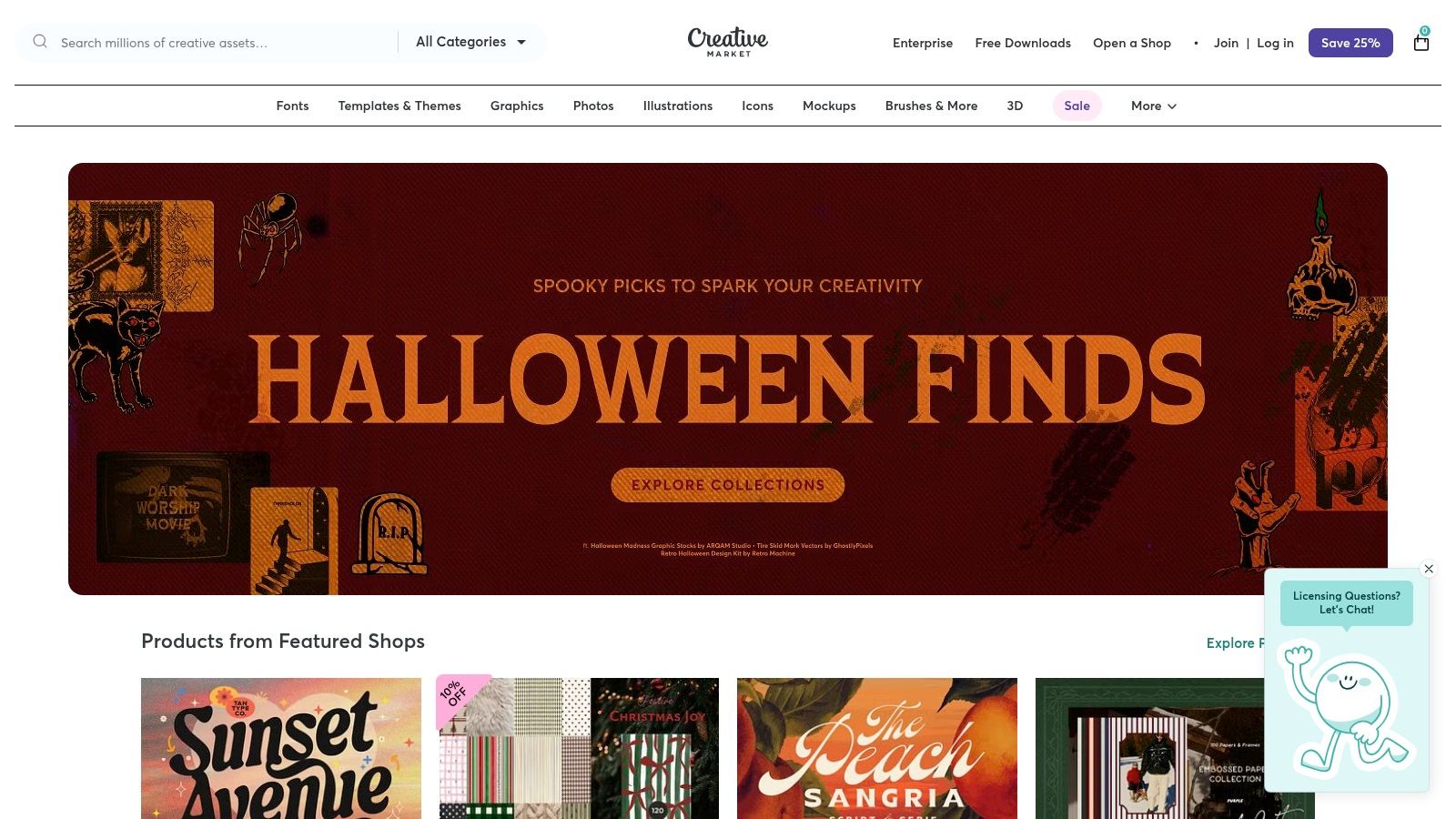
Unlike massive marketplaces, Creative Market feels more like a curated gallery. Each creator has their own shop page, allowing you to browse their entire portfolio, read reviews, and get a sense of their design style. This setup fosters a community feel and helps you find designers whose work consistently aligns with your needs. Purchases are straightforward, with instant downloads and clear licensing that simplifies usage for personal or commercial projects.
Finding Design-Centric Templates
The platform's user experience is clean and intuitive, making it easy to discover new and popular templates. You can filter results by category (like portfolio or e-commerce), price, file type, and specific properties such as "responsive." Frequent sales, bundles, and even weekly free goods provide opportunities to acquire premium assets at a reduced cost.
Pro Tip: Follow your favorite designers on the platform. This keeps you updated on their latest releases and sales, ensuring you don't miss out on high-quality templates that fit your aesthetic preferences.
Licensing and Creator Support
Creative Market offers simple licensing tiers: Personal, Commercial, and Extended Commercial, making it easy to choose the right one for your project. Since each template is sold by an independent creator, the level and speed of technical support can vary. It’s crucial to check a seller’s reviews and response times before buying if you anticipate needing help with customization.
Here’s a summary of what Creative Market offers:
- Aesthetic Variety: A strong focus on modern, design-led HTML and landing page templates.
- Simple Licensing: Clear and easy-to-understand license options for different use cases.
- Creator-Driven Shops: Direct access to individual designers' portfolios and reviews.
- Variable Support: Technical support and updates depend entirely on the individual creator.
Creative Market is a key destination for anyone prioritizing visual appeal and is considered one of the best web design tools for sourcing unique, high-quality designs.
Website: https://creativemarket.com
5. WrapBootstrap (Bootstrap-focused marketplace)
WrapBootstrap carves out a specific and valuable niche in the template marketplace by focusing exclusively on themes, dashboards, and UI kits built with Bootstrap. This specialization makes it a prime destination for developers who are committed to the Bootstrap ecosystem and need well-structured, consistent code. By concentrating on a single framework, WrapBootstrap ensures a higher baseline quality and easier integration for those building admin panels, SaaS interfaces, and complex web applications.
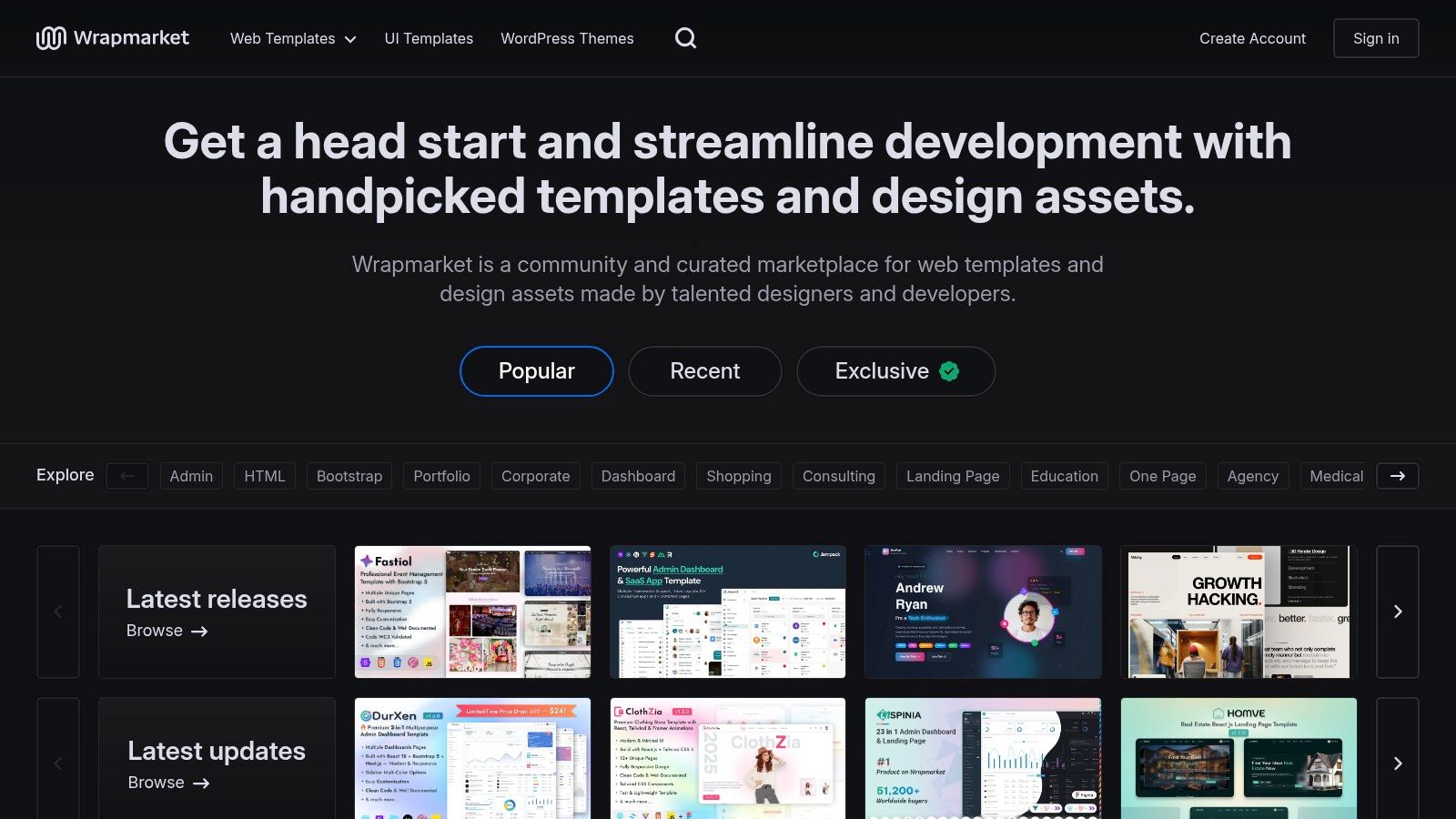
The platform’s key differentiator is its developer-centric approach. Templates on WrapBootstrap are known for their clean code and adherence to Bootstrap best practices, which is a significant advantage over larger, more generalized marketplaces where quality can be inconsistent. The focus on responsive web design templates for professional applications like admin dashboards and SaaS starter kits means you’re getting a product designed for functionality and scalability from the ground up.
Finding the Right Bootstrap Theme
While the catalog is smaller than general-purpose sites, it's highly curated. The interface allows you to filter by Bootstrap version, category (Admin, Landing Page, etc.), and other tags. This makes it simple to pinpoint a template that fits your exact technical requirements without wading through irrelevant options.
Pro Tip: Look at the "Live Preview" and the item's update history. A well-maintained template with frequent updates to support the latest Bootstrap versions is a strong indicator of a reliable and committed author.
Understanding Tiered Licensing
WrapBootstrap offers a clear, tiered licensing model that is particularly useful for developers and agencies. The licenses are designed to cover different use cases, from a single personal project to building a SaaS product sold to multiple customers. Understanding which framework fits your project is key; you can explore the differences in our Tailwind vs. Bootstrap guide.
Here’s a quick overview of what WrapBootstrap offers:
- Niche Focus: All products are built on the Bootstrap framework, ensuring code consistency.
- Clear Licensing: Tiers like Single Application, Multiple Application, and Extended are easy to understand.
- Developer-Friendly: Strong emphasis on clean, well-documented code for admin and SaaS UIs.
- Variable Support: Like other marketplaces, support quality and duration are set by individual authors.
This focused approach means you spend less time vetting code quality and more time building your application, making it an efficient choice for Bootstrap-powered projects.
Website: https://wrapbootstrap.com
6. Webflow Templates Marketplace
Webflow's official marketplace offers a highly curated collection of templates designed exclusively for its powerful visual development platform. It stands out by integrating directly with Webflow's CMS, e-commerce, and hosting solutions, making it a perfect choice for designers, freelancers, and agencies who prioritize a visual-first workflow without sacrificing code quality. These aren't just static files; they are fully functional projects ready for customization.
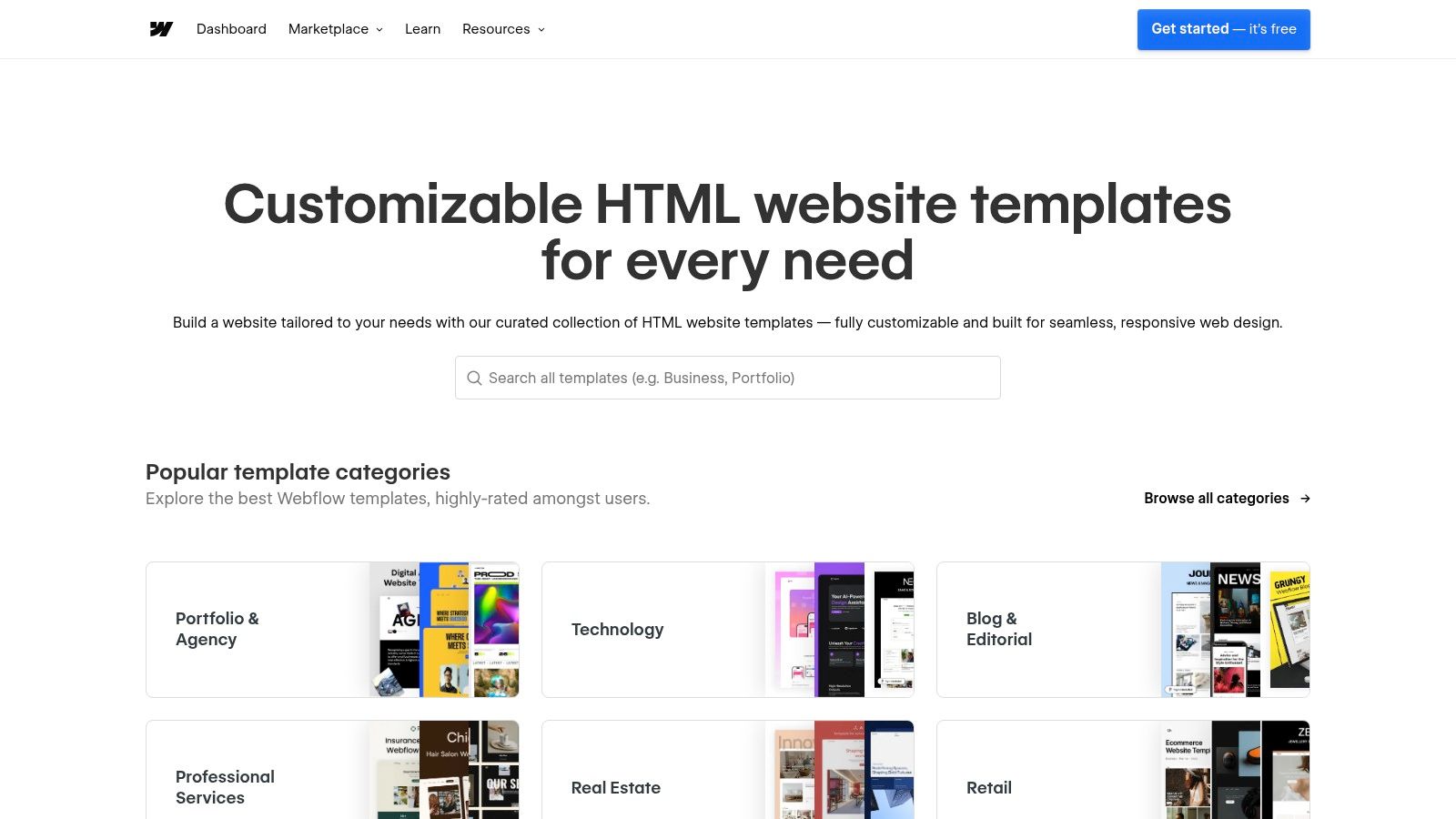
The key differentiator for Webflow is its seamless ecosystem. You can browse, purchase, and launch a sophisticated, responsive web design template entirely within the platform. This streamlined process dramatically reduces the time from concept to live site. Each template is vetted for quality and responsiveness, ensuring a high standard across the board, and comes with clear, tiered pricing based on its complexity and features.
Leveraging the Visual-First Workflow
The true power of Webflow templates is realized within the Webflow Designer. You can visually manipulate every element, interaction, and CMS connection without writing a single line of code. This makes complex customizations accessible to non-developers while still producing clean, production-ready HTML, CSS, and JavaScript.
Pro Tip: Before purchasing, use the "Open in Webflow" feature. This allows you to explore the template's structure, classes, and interactions in a read-only designer view, giving you a clear understanding of how it's built and how easy it will be to customize for your project.
Understanding Platform Integration
Webflow templates are deeply tied to the Webflow platform. While you can export the code on a paid plan to host elsewhere, you lose the powerful CMS and e-commerce functionalities, as they require Webflow hosting to operate. This makes the marketplace ideal for projects intended to be managed and hosted within the Webflow ecosystem.
Here’s a quick breakdown of what to expect:
- Seamless Integration: Templates work natively with Webflow CMS and E-commerce.
- Vetted Quality: All templates meet high standards for design, responsiveness, and performance.
- Visual Customization: Modify every aspect of the design in a powerful visual editor.
- Platform Dependency: Exporting code is possible but requires a paid plan, and dynamic features are lost.
For agencies and freelancers, this model is excellent for building client sites that are easy for them to manage and update later without needing a developer's help.
Website: https://webflow.com/templates
7. Start Bootstrap (free MIT-licensed templates)
Start Bootstrap offers a curated collection of free, open-source, and fully responsive templates built exclusively on the Bootstrap framework. It stands out by providing clean, well-documented starter kits under the permissive MIT license, making it an ideal resource for developers, students, and businesses looking for high-quality responsive web design templates without any initial cost. The platform is perfect for quickly launching landing pages, portfolios, blogs, and admin dashboards.
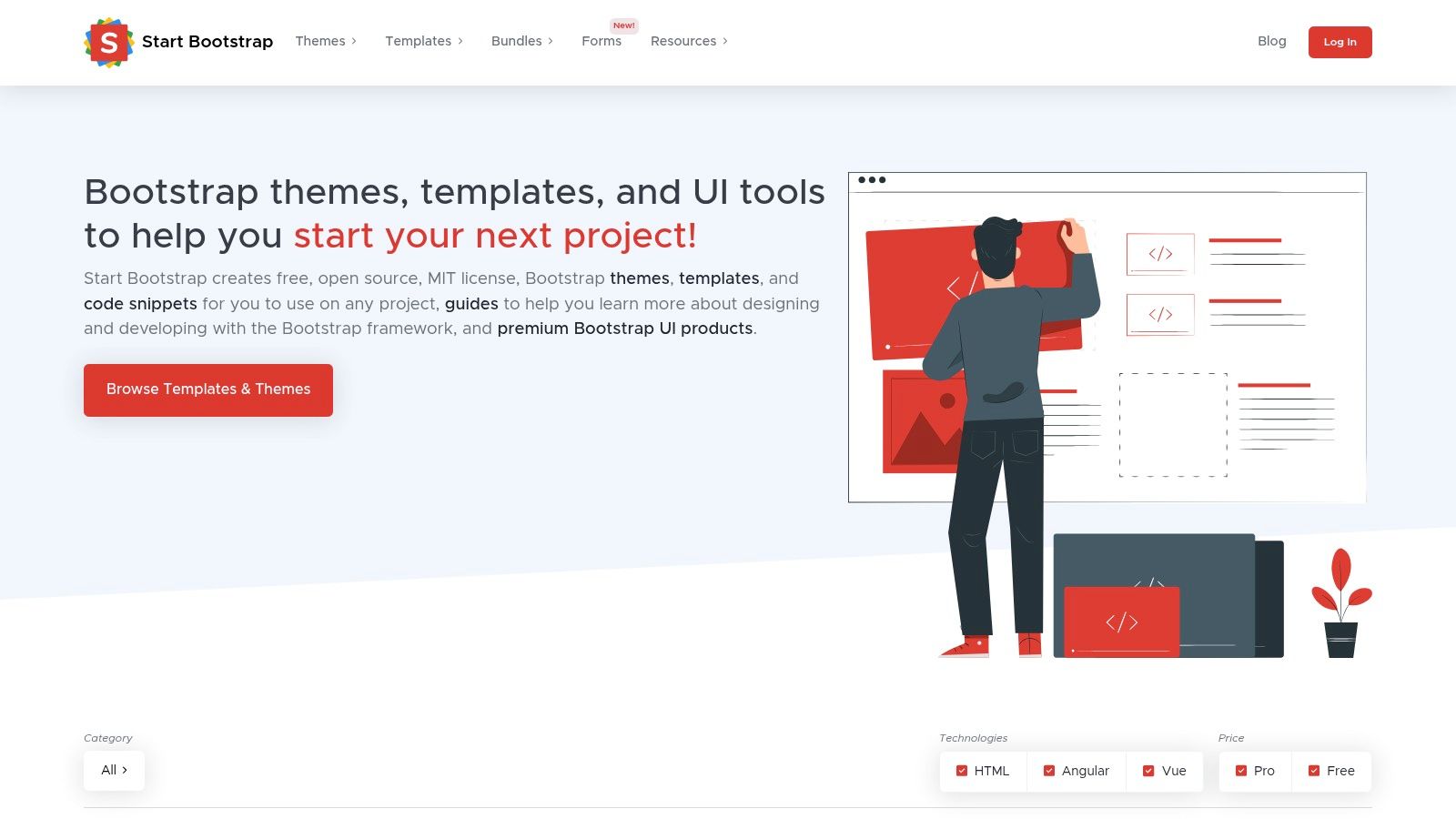
The key differentiator for Start Bootstrap is its commitment to open-source and simplicity. Unlike massive marketplaces, it focuses on quality over quantity, ensuring each template serves as a solid foundation for customization. The source code for every template is readily available on GitHub, allowing for complete transparency and community contributions. This approach empowers users to take a modern, well-structured base and adapt it to their specific needs without licensing restrictions.
Getting Started with Free Templates
The platform is incredibly straightforward. You can browse templates by category, view a live preview, and download the source files with a single click. Since all templates are based on Bootstrap 5, you can be confident that they adhere to the latest web standards and are easy to modify if you're familiar with the framework.
Pro Tip: Before downloading, check the template's GitHub repository. You can review the commit history to see how actively it's maintained and read through any open issues to understand potential limitations or community-reported bugs.
Understanding the MIT License
The use of the MIT license is a significant advantage. It allows you to use, copy, modify, merge, publish, distribute, sublicense, and sell copies of the software with very few restrictions. This freedom is invaluable for freelancers building sites for clients or startups creating commercial products, as there are no hidden fees or complex licensing terms to navigate.
Here’s a quick summary of what Start Bootstrap offers:
- Completely Free: All primary templates are free to download and use under the MIT license.
- Bootstrap 5 Foundation: Built on the latest version of the world's most popular front-end framework.
- Open-Source Code: Source files are available on GitHub and npm for easy integration into your development workflow.
- Easy to Customize: The clean, well-commented code makes modification simple for developers.
- User-Managed: You are responsible for your own hosting and deployment, giving you full control over your environment.
While the core offerings are free, Start Bootstrap also provides optional premium themes and bundles for users who need more advanced features or designs.
Website: https://startbootstrap.com
Responsive Web Design Templates Comparison
| Item | Implementation Complexity | Resource Requirements | Expected Outcomes | Ideal Use Cases | Key Advantages |
|---|---|---|---|---|---|
| Magic UI Pro — SaaS Template | Moderate (requires React & Tailwind knowledge) | Developer/designer time, modern stack | High-performance, SEO-friendly SaaS landing pages | SaaS startups and businesses | Latest tech, 14 prebuilt sections, built-in blog, dark mode |
| ThemeForest (Envato Market) | Variable (depends on chosen template) | Varies by product, some coding skills | Wide variety of templates for multiple niches | Buyers seeking variety and competitive pricing | Huge selection, active updates, clear licensing |
| TemplateMonster + MonsterONE | Variable | Single purchase or subscription | Access to broad template library, frequent updates | Agencies/freelancers needing many assets | Flexible buying options, 24/7 support |
| Creative Market (HTML Templates) | Variable | Basic web skills | Design-forward templates with modern aesthetics | Designers looking for unique, aesthetic options | Large design variety, frequent sales/bundles |
| WrapBootstrap (Bootstrap only) | Low to moderate (Bootstrap familiarity needed) | Bootstrap knowledge, moderate coding | Clean, consistent Bootstrap templates focused on SaaS | Developers needing Bootstrap-specific themes | High code quality, clear licensing, niche focus |
| Webflow Templates Marketplace | Low (visual design, minimal coding) | Webflow subscription for code export | Fully responsive, CMS/e-commerce integrated sites | Visual-design users and agencies | Fast setup, consistent pricing, strong community |
| Start Bootstrap (free MIT) | Low to moderate (Bootstrap knowledge) | Minimal costs, self-hosting | Free, open-source Bootstrap templates for quick start | Users needing free, customizable starter kits | Free MIT license, clean code, large community |
Choosing Your Foundation for a Responsive Future
Selecting the right responsive web design template is a foundational step that echoes through your entire development lifecycle. It's far more than a cosmetic choice; it's a strategic decision that directly influences your project's speed, scalability, and ultimate success. Throughout this guide, we've explored a diverse range of platforms and tools, each tailored to different needs, skill levels, and project goals.
From the developer-centric, high-performance components of Magic UI Pro to the sprawling, all-encompassing marketplaces like ThemeForest and TemplateMonster, the options are vast. We've seen how specialized collections like WrapBootstrap cater to framework loyalists, while platforms like Webflow offer a powerful visual development paradigm. The key takeaway is that the "best" template doesn't exist in a vacuum; it's the one that best aligns with your unique requirements.
How to Make Your Final Decision
To move from analysis to action, consider these critical factors. Your final choice should be a deliberate balance between your immediate needs and long-term vision. Don't just pick a template that looks good today; choose a foundation that will support your growth tomorrow.
1. Evaluate Your Technical Expertise:
- Developers & Startups: If your team is comfortable with modern frameworks like React, Next.js, and Tailwind CSS, a tool like Magic UI Pro offers unparalleled control and performance. It provides the building blocks for a custom, high-speed application without the bloat of traditional themes.
- Freelancers & Agencies: Marketplaces like ThemeForest or Creative Market provide variety and quick turnarounds for client projects. For those using Bootstrap, WrapBootstrap is a focused and reliable source.
- Visual Builders & Beginners: Webflow's Template Marketplace is ideal if you prefer a visual, no-code, or low-code approach, empowering you to build complex layouts without writing extensive code.
2. Align with Project Scope and Budget:
- High-Stakes Applications: For SaaS platforms, enterprise tools, or any project where performance and user experience are non-negotiable, investing in a premium, well-coded template is crucial. The upfront cost is often offset by saved development hours and easier maintenance.
- MVPs and Personal Projects: For launching a minimum viable product, a personal blog, or experimenting with a new idea, free resources like Start Bootstrap are invaluable. They provide a solid, no-cost entry point to get your project online quickly.
3. Prioritize Long-Term Maintainability:
- A template is a living part of your project. Before committing, check for clear documentation, a history of recent updates, and access to developer support. An abandoned template can become a significant technical liability. This is where curated, actively maintained libraries truly shine.
Ultimately, the goal of using responsive web design templates is to build a seamless, accessible, and engaging experience for every user, regardless of their device. By carefully weighing these factors, you can select a foundation that not only accelerates your launch but also empowers you to build a robust and future-proof digital presence.
Ready to build faster with components designed for modern web development? Magic UI offers a library of over 100 free, open-source, and professionally designed components built with React, Next.js, and Tailwind CSS. Explore our collection and see how you can create stunning, responsive user interfaces with ease at Magic UI.
